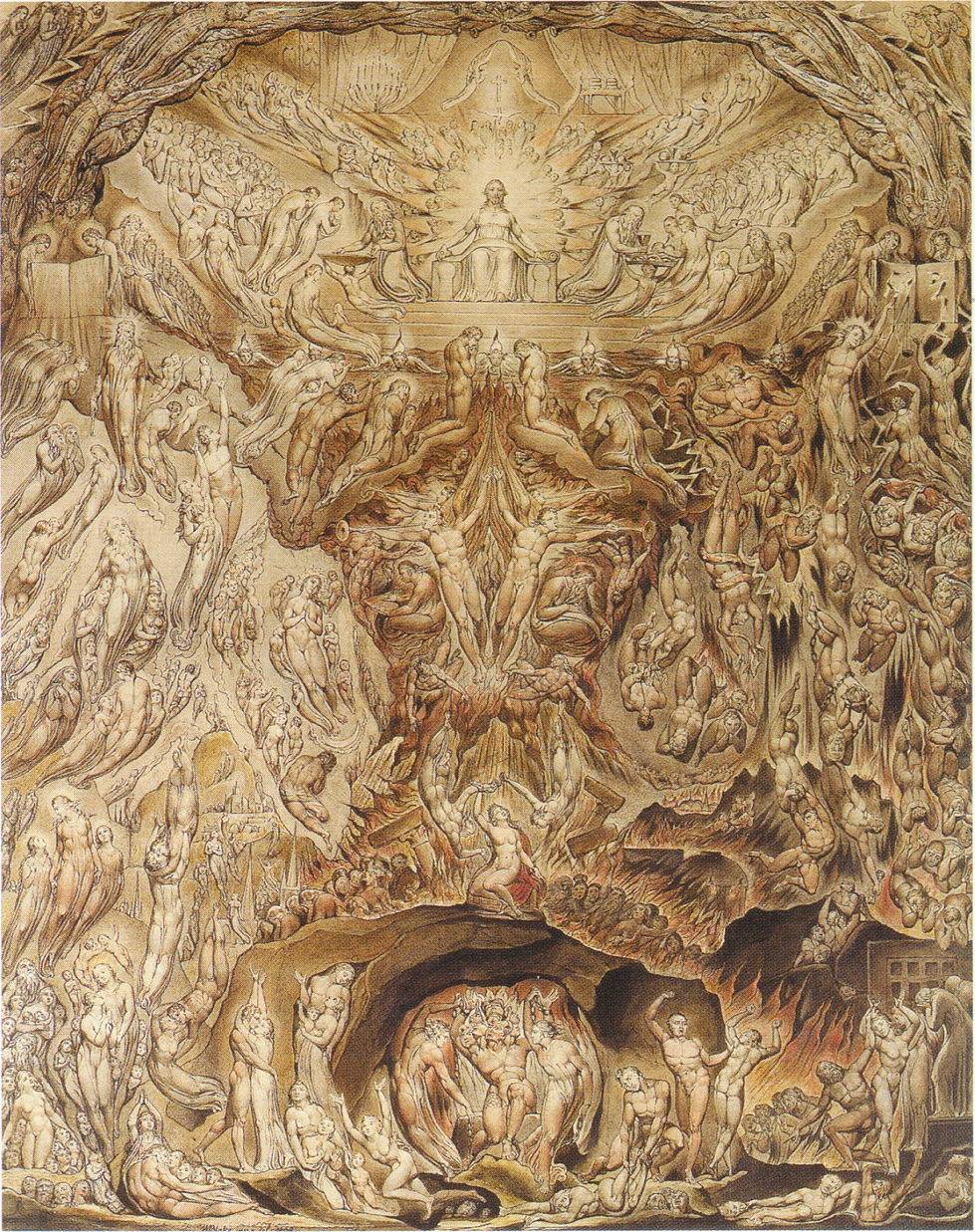A Vision of the Last Judgement’ (1808), pen and ink and water-colour on paper, William Blake (1757–1827)
William Blake wrote to Humphrey with an explanation about the last judgment, explaining that it depicts the resurrection. The top of the work depicts Christ on the Throne of Judgement with Heaven opened up across the painting. Behind Christ are the heads of infants which represent creation coming from Jesus. Christ is surrounded by the four Zoas and seven angels that have vials filled with God’s wrath. An image of a tabernacle with a cross inside is depicted above Christ. An image of baptism is to Christ’s right and the Last Supper is to Christ’s left with both representing eternal life. Further to Christ’s right is the resurrection of the just and to the left is the resurrection and subsequent fall of the wicked. Adam and Eve are below Christ, and Abraham and Moses are nearby. Below Moses is Satan wrapped by the Serpent and in the centre is the book of death. At the top is the book of life, and the Christian Church is the figure of a woman on top of the moon.
Blake, in his notes to A Vision of the Last Judgement, describes how his design is to work: “If the Spectator could Enter into these Images in his Imagination approaching them on the Fiery Chariot of his Contemplative Thought […] then would he arise from his Grave”. He relies on the word representation frequently in the work, and he tries to represent action in a visible manner that distances his depiction of the apocalypse from a traditional version that disguises the various components of an apocalyptic vision. To Blake, he must create an image of the Last Judgement, then represent the image, and then describe with a written gloss of the work. This creates a layer of representation that separates the audience from the apocalyptic experience, which undermines the concept of apocalypse as both mysterious and directly experienced.
In discussing the nature of time, Blake wrote in his notes: “The Greeks represented Chronos or Time as a very Aged Man; this is Fable, but the Real Vision of Time is in Eternal Youth. I have, however, somewhat accommodated my Figure of Time to the common opinion, as I myself am also infected with it & my Visions also infected, as I see Time Aged, alas, too much so.”
Themes
Blake based his portrayal of the apocalypse on his belief that God’s love allowed for a personal apocalypse as part of the human experience. In the notes to the work, he claimed that “whenever any Individual Rejects Error & Embraces Truth a Last Judgement passes upon that Individual”. This idea is connected to views of David Hartley of the “pure disinterested love of God”, and appears in other works by Blake, including his Jerusalem. Also, Blake’s Milton describes the process that an individual goes through during an apocalypse, which includes having to confront their errors and their flaws. There is no peace during the struggle, as it involves a direct interaction between contrary views that would eventually establish the new state.
On the details in the painting, Blake claimed that each component had a specific meaning that provides an allegory-like dimension to the work. Blake dismissed the idea of using allegory within his works except, as he wrote in a letter to Butts, 6 July 1803,”Allegory Address’d to the intellectual powers, while it is altogether hidden from the Corporeal Understanding, is My Definition of the Most Sublime Poetry”.
Blake’s philosophical interpretation of time is similar to Samuel Taylor Coleridge’s depiction of the relationship between time and the state of limbo within his poem “Limbo”. Both claim that their understanding of time is connected to the common, contemporary view, but they alter their perspective of time within their works to that of an older person. The figure of time appears in other works by Blake, including as the figure Los and in the illustration Blake made for Edward Young’s Night Thoughts.


Leave A Comment